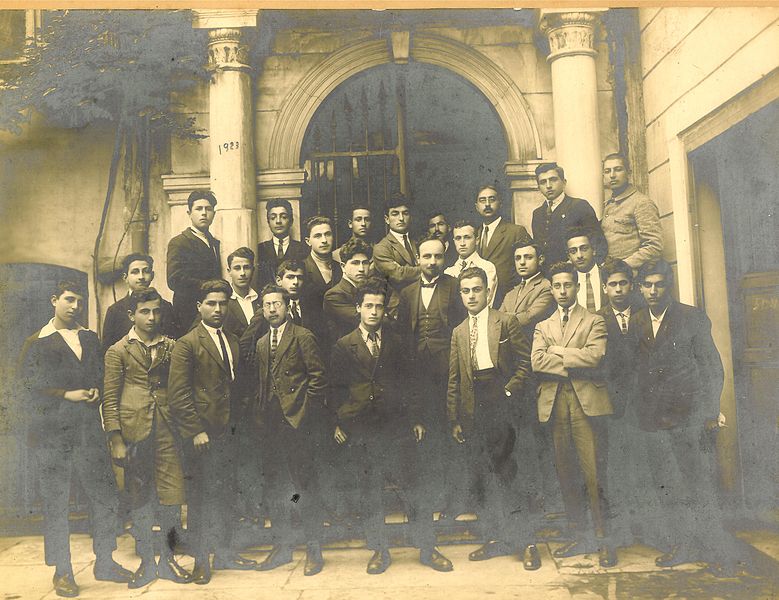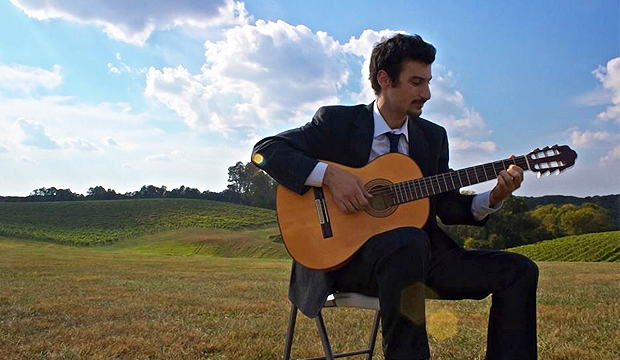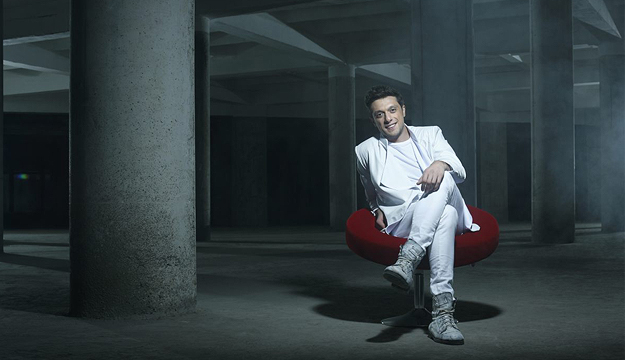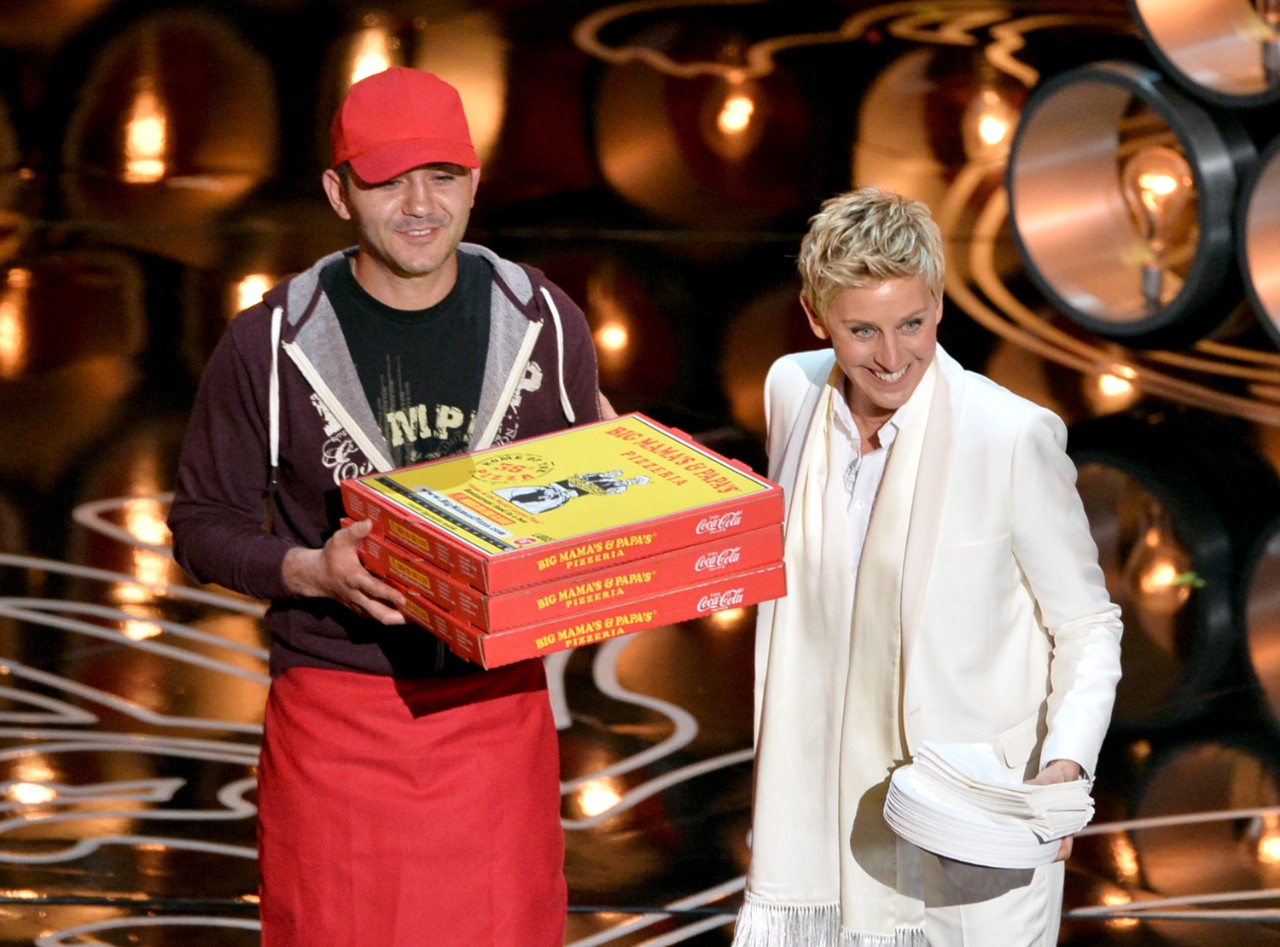Q&A: Los Animales Web Comic Creators Liz Ohanesian and Jeaux Janovsky
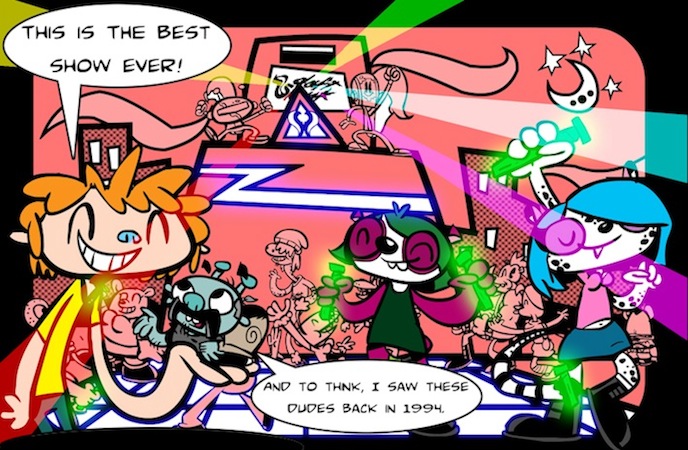
“Los Animales,” an original web comic created by journalist Liz Ohanesian and cartoonist Jeaux Janovsky has hit the web to rave reviews. The comic follows the misadventures of Manda Pandarosian and Pedro Lionovsky and their friends at Animal Sounds Records, where they both work, as they navigate life, love, music and glow sticks.
Ohanesian is a freelance writer based in L.A. whose work has appeared in L.A. Weekly, Hi-Fructose and Los Angeles magazine among others. She’s also a convention queen, filing regularly from Anime Expo and San Diego’s Comic-Con. And if that didn’t up the cool factor already, she’s also a DJ, playing at clubs around L.A. and currently a resident at Club Underground.
Janovsky, a graduate of the California Institute of the Arts, has worked for such companies as Disney, Mattel, Next New Networks and Frederator, producers of the Cartoon Network hit Adventure time, among others.
We interviewed the duo, who met in high school and share a mutual love of The Cure about the challenges of putting together a web comic, their cultural background, the nostalgia of record stores and more.
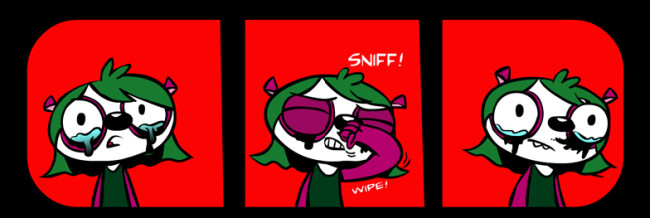
Q. Could you tell me about the inception and development of “Los Animales?” How did guys decide the format you wanted this to be mean, as in, a web comic?
Liz: Years ago, I was editing a now-defunct music newspaper called The Rockit. Jeaux and I did a comic strip called Animal Sounds that ran in the paper. (I wrote it under the alias Violet Peters.) It was a gag strip that took place in a record store and early versions of Manda, Pedro and Ian appeared in it.
We stopped doing the strip when Jeaux moved to New York. A few years passed and Jeaux moved back to L.A. At the time, I was working at L.A. Weekly. We were both preoccupied with other work for a long time. One day, though, Jeaux called me and said that he wanted to pitch Animal Sounds as an animated series. I was getting bored with my job, so I was like, “Okay, let’s do that.” We spent a couple days putting together a pitch bible. I didn’t know what I was doing. The pitch bible was nothing like the comic you’re reading now. I think the only thing we ended up keeping was the premise of “Fours on the Floor,” the first chapter.
Nothing happened in the TV world, so we figured that, since we already did a ton of work, we might as well make it a webcomic and make something that’s for adults, as opposed to kids or teenagers. By this time, I was freelancing again, so there was really nothing holding me back from doing all the writing. Jeaux and I spent a year working on this in between our freelance gigs. Eventually, we had Los Animales.
Jeaux: We’ve been working on Los Animales, off and on for about 7 years in many different incarnations. It started life in 2006 as a b/w comic strip called “Animal Sounds” in The Rockit, a rock and roll newspaper Liz was editing at the time. From there, in 2009, it leapt to a couple issues of Las Vegas Rocks! magazine, a Sin City magazine devoted to music and rock and roll. Same comic strips, but this time in full color. Around that same time, I had moved back to LA from NY and still thought we had something special w/ Animal Sounds. Liz and I put together an Animal Sounds pitch packet and I began shopping it around Hollywood, and pitching it to all the big animation companies. This version was massively toned down, since we were pitching it as a kids cartoon. Animal Sounds getting passed on turned out to be the best thing that could happen to us. We realized we still had something great, we love the characters, their stories, and their world, and that we should just be punk rock and self publish it ourselves. That’s more in the spirit of the comic anyhow. As far as going the webcomic route? Truthfully, self publishing costs a lot, and for now publishing it on the web seemed like the best option. It’s better for our wallets, is cost effective, we can reach a wider audience, and begin building our fanbase, it’s free for our readers, and it looks great on your computer, iPhone, iPad, etc.
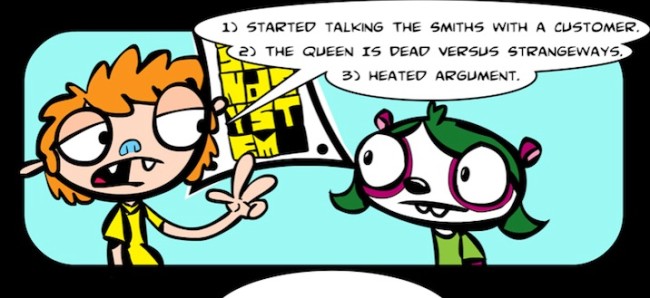
Q. What/who were the inspirations? I sense a very familiar ‘ian’ in Manda’s last name and since this is a Caucasus/Diasporan publication, I have to ask – how much of your Armenian identity played into Manda’s character and what was it like growing up as an Armenian-American in L.A.? Is Jeaux’s ethnic background reflected in the character of Pedro as well?
Liz: While, this isn’t an autobiographical comic, I do identify with Manda, so I wanted to give her a last name that resonated with me. Pandarosian is basically a portmanteau of panda and Bedrosian, so it’s a nod to my mom’s side of the family. (Fun fact: my old alias, Violet Peters, is the American version of my great-grandma’s name.)
Ethnicity isn’t something that we ever discussed going into the comic and I doubt it’s something that will ever be addressed in a conventional way, just on account of the fact that we’re dealing with characters who aren’t human. However, we wanted to make this world that we created, at least in some ways, reflective of our own. Given our background, growing up in the San Fernando Valley, it was very natural for us to give our characters names that aren’t of the standard Anglo-American variety. Also, because I have a real personal attachment to Manda– her experiences are, in some ways, quite similar to my own and she reacts as I would– I felt like she had to have a name that at least sounded like it could be Armenian. I think it’s important that our long and, typically, mispronounced last names become a part of American pop culture.
I remember watching The Simpsons with my family one night years ago. In the episode, Principal Skinner was revealed to be a guy named Armen Tamzarian. We were laughing and shouting, “Principal Skinner is one of us!” If anyone sees Manda’s full name and does the same thing, it would pretty much be the highlight of my career.
I’m the third generation born in the U.S. My paternal great-grandparents were amongst the Russian Armenians who settled in Boyle Heights in the early 1900s. My maternal great-grandparents were Genocide survivors who wound up in Cleveland. So, I kind of grew up with an interesting mix of cultures. We don’t speak Armenian fluently in my family, but we use Armenian words as slang. We have pilaf and boureg with traditional American holiday food.
Jeaux: My ethnic background is Costa Rican (my mom’s side) & Russian/Bohemian (my father’s side). Pedro has no real resemblance to me, save for maybe his crazy mane of hair and his little pot belly. Also, he’s a red-headed lion ginger. I don’t necessarily think of cultural identities when I’m sketching/creating the characters. Maybe it has something to do with the multiracial hybrid mutt dual cultures inside of me, being a mixed-race individual. It would be fascinating to explore that though in the future!
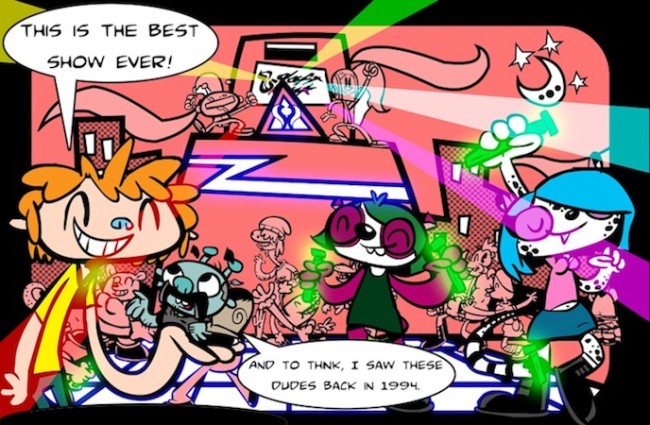
Q. What is the writing/animating process like? Have you guys faced any significant challenges?
Liz: I was never really sure how to write a comic book, so I wrote the scripts at 22-page screenplays. That’s actually a much longer comic. I think the first chapter is something like 52 pages. I try to write everything ahead of time. “Fours on the Floor” was written over a year ago. The first draft of Chapter 2, “Nadarave,” was written last summer, but I rewrote it several times since then. I’m in the midst of finishing Chapter 3 right now. As much as I try to write ahead, I’m still editing until the page goes live. Then I start thinking about what I could have done better.
Jeaux can tell you more about the drawing process.
Because I’m writing the scripts like screenplays and because we’re running one page every weekday, it’s kind of like constructing and then deconstructing a sitcom. That’s weird. I’m trying to work on the pacing so that it’s kind of exciting every day, but, at the end of six weeks or whatever it is, you still have a full episode. I think I worked out some of those kinks in Chapter 2, but it’s still a work-in-progress.
Jeaux: Liz usually writes a script, then rewrites it, and whittles it down until she’s happy enough with the final version that she sends to me. From there I thumbnail her script. Thumbnails are small, nearly stick figure like scribbles of the characters and panel/page layouts. Usually they are littered with my notes, and my interpretations of Liz’s script. Occasionally, if I can think of a visual gag I’ll slip it in. The thumbnails are sort of my little storyboards for the final comic. From there I use a program called Flash to do a bulk of the artwork. It’s all digital. Flash is a computer program primarily used for animation. I use a Wacom tablet that allows me to draw everything from sketches to final inks onto the computer in the program. It has been a lifesaver, as you can recycle and reuse art in it. It comes in very handy for crowd scenes. After I layout the page and finish my inks, I’ll bring the final page into another computer program called Photoshop where I’ll color the page and add text and word balloons. We have a whole comic studio in a box! As far as challenges, I’m not the best creative person when it comes to time management. As Los Animales is a daily comic, it’s really been forcing me to keep to a schedule and shape up my time management skills (somewhat). I have my moments of tardiness sometimes, but it’s a start.
Q. Since Animal Sounds Records is the setting for the web comic, can you tell me about what record stores mean to you?
Liz: I never worked in a record store, but because I collect vinyl and have done quite a bit of DJing, I’ve spent a lot of time in record stores.
When I started collecting records, there were tons of stores across L.A. My friend and I would basically drive across the whole county looking for stuff. Some of the Hollywood stores were hyper-specialized and were really good for new music. For example, if I wanted goth and industrial stuff, I went to Vinyl Fetish. When I wanted some new indie rock 7″, I went to No Life. But, the stores in the suburbs were goldmines of awesome ’80s records that they would sell for cheap. More often than not, I would come out with loads of really cool, kind of hard-to-find 12″ singles and albums that I bought for $2.99 a pop. I would spend hours inside record stores just digging until I found those records.
When Amoeba came to town, a lot of those stores started to close. The ones that survived the big record department store often didn’t survive the rise of the MP3. It’s sad. What’s sadder though is that, with fewer record stores and the increased coolness of vinyl, record shopping has gotten way more expensive. Because of that, I’m more careful about what I buy now. I still go record shopping as often as I can though and I’m still trying to put together the best collection of synthpop and ’80s alternative vinyl in town. I’m nowhere near finished on this mission.
Jeaux: Record stores are almost post-apocalyptic now, or like spotting Bigfoot or the Lochness Monster. Almost like a myth. I used to spend hours of my youth at used record stores, digging through the used CDs or cassette tapes for that rare find or finding that one weird homemade item. I almost miss getting silently judged by the record store employees for bringing in a used CD or two. It’s almost nostalgic for me now. The other day, a friend and I decided to go to a used record store location (CD Trader in Tarzana) that’s still open near me that I used to go to back in high school. We were lost in a sea of used vinyl, cassettes, CDs and that familiar record store smell and silent glaring from the clerks behind the counter. It was like time traveling back to a simpler time.
In a way, our comic and characters are sort of clinging to these dying businesses that the internet has destroyed. Maybe that’s why it strikes a chord with our generation.
Q. What has the response been so far to “Los Animales?”
Liz: So far, it’s been pretty good. Our readership is small, but growing, and we’re very fortunate to have friends who genuinely like what we do and are willing to help us spread the word.
A lot of people mention “nostalgia” when they talk about what they like about Los Animales. The funny part about that is that the story is set in the present day. I don’t think we meant for the comic to be nostalgic. We try to mix old music references with new ones. But, we also did create these characters knowing that they were going to be nostalgic for the pre-MP3 world. So, I guess, in that sense, the sentiments are totally understandable.
Jeaux: For a brand new webcomic on the block by two N00bies who have never done a proper online comic before? Pretty amazing actually! Luckily, Liz is a genius at analyzing our web statistics and we get a really good amount of traffic for a newborn baby comic! Just a couple months old, not even old enough to crawl yet!
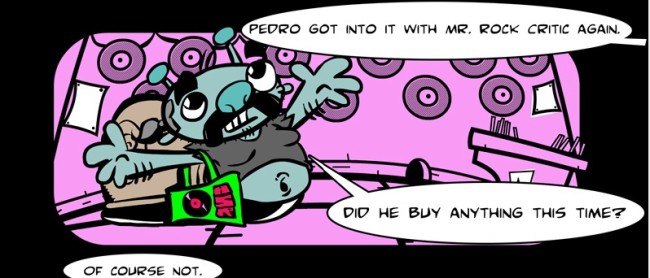
Q. What do you have in store for the future of “Los Animales?”
Liz: The first thing we’re trying to do is build our audience. We are planning on selling merch, but that won’t be available until at least this summer. We also want to release hard copies of Los Animales at some point, but we’re not going to worry about that until after Chapter 3, which will run this summer.
We will likely be at some conventions this year, but I’m not sure in what sort of capacity. Both of us are definitely going to San Diego Comic-Con. We’re going more for general work reasons, but we’ll probably have something Los Animales on us while we’re there.
Jeaux: We’ve got a lot of plans in the works behind the scenes for LA. I’m not sure if I can mention some of the ideas right now, but what I can mention and promise for sure is definitly more stories, more characters, more music, and more drama!
Check out the first chapter of Ohanesian and Janovsky’s Los Animales. Chapter 2 is forthcoming.


